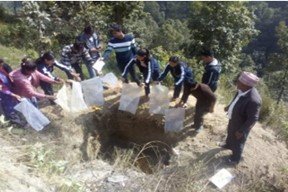Life cycle and eco-friendly management of Chinese fruit fly (Bactrocera minax) in sweet orange (Citrus sinesis Osbeck) in Nepal
Abstract
Sweet orange (Citrus sinensis Osbeck) is a highly profitable fruit crop of Nepal. However, for the past five years, farmers experienced poor productivity partly attributed to the severe infestation of exotic Chinese fruit fly (Bactorcera minax), particularly in Sindhuli and Ramechhap district of Nepal. In this context, we attempted to review on identification, life cycle, and eco-friendly management of Chinese fruit fly. The review is documented based on a field visit and relevant works of literature from Journal articles, books, pamphlets, etc. The Chinese fruit fly has tremendous ability to take a long-range flight, thus, migrated from China to Bhutan and crossing the Indo-Nepal eastern border, finally reached to eastern mid-hills of Nepal. Moderate temperature and low humidity of mid-hills of Nepal are favorable for the exponential growth of the pest. Being sweet orange most preferable commodity, the host range of the fly includes almost all the citrus fruits. The fly has damaged 20-50% of the fruit every year and resulted in a loss of millions of rupees. Therefore various pest management practices can be deployed for sustainable eco-friendly management of the pest. The Chinese fruit fly can be successfully managed by hydrolase protein baits, regular pruning, augmentation of bio-control agents, and using soft systemic insecticides. Various other options for the management of Chinese fruit fly are also discussed with their biological efficacy for the sustainable and eco-friendly management of pests.
Keywords:
Bio-control agents, Eco-friendly management, Protein baits, Systemic insecticidesDownloads

Published
How to Cite
Issue
Section
Copyright (c) 2020 Agriculture and Environmental Science Academy

This work is licensed under a Creative Commons Attribution-NonCommercial 4.0 International License.

